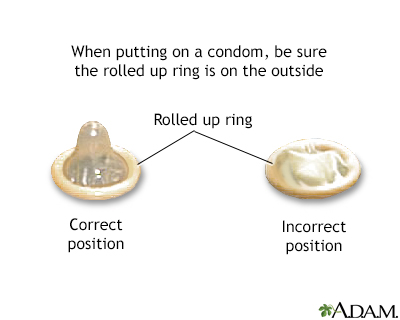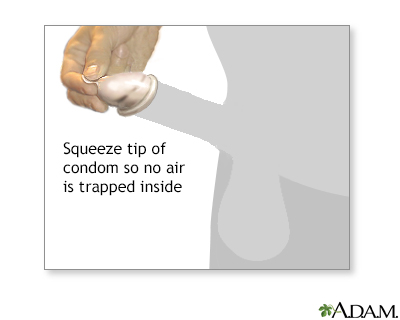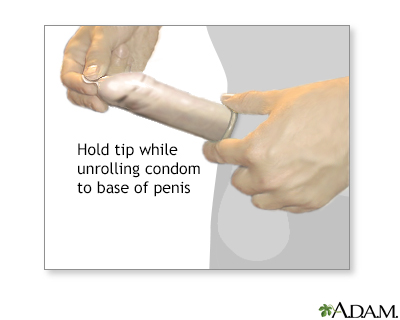Condoms - male
Prophylactics; Rubbers; Male condoms; Contraceptive - condom; Contraception - condom; Barrier method - condomA condom is a thin cover worn on the penis during intercourse. Using a condom will help prevent:
- Female partners from becoming pregnant.
- Getting an infection spread through sexual contact, or from giving one to your partner. These infections include herpes, chlamydia, gonorrhea, HIV, and warts.
Chlamydia
Chlamydia is an infection caused by the bacteria Chlamydia trachomatis. It is most often spread through sexual contact.
 ImageRead Article Now Book Mark Article
ImageRead Article Now Book Mark ArticleGonorrhea
Gonorrhea is a common sexually transmitted infection (STI).
Read Article Now Book Mark Article
Condoms for women can also be purchased.
Condoms for women
The female condom is a device used for birth control. Like a male condom, it creates a barrier to prevent the sperm from getting to the egg....

Information
The male condom is a thin cover that fits over a man's erect penis. Condoms are made of:
Penis
The penis is the male organ used for urination and sexual intercourse. The penis is located above the scrotum. It is made of spongy tissue and bloo...

- Animal skin (This type does not protect against the spread of infections.)
- Latex rubber
- Polyurethane
Condoms are the only method of birth control for men that are not permanent. They can be purchased at most drugstores, in vending machines in some restrooms, by mail order, and at certain health care clinics. Condoms do not cost very much.
HOW DOES A CONDOM WORK TO PREVENT PREGNANCY?
If the sperm contained in a male's semen reach a woman's vagina, pregnancy may occur. Condoms work by preventing sperm from coming in contact with the inside of the vagina.
If condoms are used correctly every time intercourse occurs, the risk of pregnancy is around 3 out of every 100 times. However, there is a higher chance of pregnancy if a condom:
- Is not used correctly during sexual contact
- Breaks or tears during use
Condoms do not work as well at preventing pregnancy as some other forms of birth control. However, using a condom is much better than not using birth control at all.
Some condoms contain substances that kill sperm, called a spermicide. These may work slightly better to prevent pregnancy.
A condom also prevents the spread of certain viruses and bacteria that cause diseases.
- Herpes may still be spread if there is contact between the penis and the groin area outside of the vagina.
- Condoms do not fully protect you from the spread of warts.
HOW TO USE A MALE CONDOM
The condom must be put on before the penis comes into contact with the outside of the vagina or enters the vagina. If not:
- The fluids that come out of the penis before climax carry sperm and may cause pregnancy.
- Infections can be spread.
The condom must be put on when the penis is erect, but before contact is made between the penis and vagina.
- Be careful not to tear or poke a hole in it while opening the package and removing the condom.
- If the condom has a little tip (receptacle) on the end of it (to collect semen), place the condom against the top of the penis and carefully roll the sides down the shaft of the penis.
- If there is no tip, be sure to leave a little space between the condom and the end of the penis. Otherwise, the semen may push up the sides of the condom and come out at the bottom before the penis and condom are pulled out.
- Be sure there is not any air between the penis and the condom. This can cause the condom to break.
- Some people find it helpful to unroll the condom a little before putting it on the penis. This leaves plenty of room for semen to collect. It also prevents the condom from being stretched too tightly over the penis.
- After semen is released during climax, remove the condom from the vagina. The best way is to grasp the condom at the base of the penis and hold it as the penis is pulled out. Avoid having any semen spill into the vagina.
IMPORTANT TIPS
Make sure you have condoms around when you need them. If no condoms are handy, you may be tempted to have intercourse without one. Use each condom only once.
Store condoms in a cool, dry place away from sunlight and heat.
- Do not carry condoms in your wallet for long periods of time. Replace them every once in a while. Wear and tear can create tiny holes in the condom. But, it is still better to use a condom that has been in your wallet for a long time than to not use one at all.
- Do not use a condom that is brittle, sticky, or discolored. These are signs of age, and old condoms are more likely to break.
- Do not use a condom if the package is damaged. The condom may be damaged as well.
- Do not use a lubricant with a petroleum base, such as Vaseline. These substances break down latex, the material in some condoms.
If you feel a condom break during intercourse, stop right away and put on a new one. If semen is released into the vagina when a condom breaks:
- Insert a spermicidal foam or jelly to help reduce the risk of pregnancy or passing an STD.
- Contact your health care provider or pharmacy about emergency contraception ("morning-after pills").
Emergency contraception
Emergency contraception is a birth control method to prevent pregnancy in women. It can be used:After a sexual assault or rapeWhen a condom breaks o...
 ImageRead Article Now Book Mark Article
ImageRead Article Now Book Mark Article
PROBLEMS WITH CONDOM USE
Some complaints or problems with condom use include:
- Allergic reactions to latex condoms are rare, but can occur. (Changing to condoms made of polyurethane or animal membranes may help.)
- Friction of the condom may cut down on sexual enjoyment. (Lubricated condoms may reduce this problem.)
- Intercourse also may be less pleasurable because the man must pull out his penis right after ejaculation.
- Placing a condom may interrupt sexual activity.
- The woman is not aware of warm fluid entering her body (important to some women, not to others).
References
Centers for Disease Control and Prevention website. How to use a condom. www.cdc.gov/condom-use/resources/external.html?CDC_AAref_Val=https://www.cdc.gov/condomeffectiveness/external-condom-use.html. Updated April 3, 2024. Accessed June 19, 2024.
Pepperell R. Sexual and reproductive health. In: Symonds I, Arulkumaran S, eds. Essential Obstetrics and Gynaecology. 6th ed. Philadelphia, PA: Elsevier; 2020:chap 19.
Swygard H, Cohen MS. Approach to the patient with a sexually transmitted infection. In: Goldman L, Cooney KA, eds. Goldman- Cecil Medicine. 27th ed. Philadelphia, PA: Elsevier; 2024:chap 264.
Workowski KA, Bachmann LH, Chan PA, et al. Sexually Transmitted Infections Treatment Guidelines, 2021. MMWR Recomm Rep. 2021:23;70(4):1-187. PMID: 34292926 pubmed.ncbi.nlm.nih.gov/34292926/.
-
Male reproductive anatomy - illustration
The organs of the normal male reproductive system.
Male reproductive anatomy
illustration
-
The male condom - illustration
The male condom is a barrier contraceptive made of latex or polyurethane. The condom must be fitted over the erect penis. The condom is sold over-the-counter and when used properly is an inexpensive, effective barrier to pregnancy and sexually-transmitted disease.
The male condom
illustration
-
Condom application - series
Presentation
-
Male reproductive anatomy - illustration
The organs of the normal male reproductive system.
Male reproductive anatomy
illustration
-
The male condom - illustration
The male condom is a barrier contraceptive made of latex or polyurethane. The condom must be fitted over the erect penis. The condom is sold over-the-counter and when used properly is an inexpensive, effective barrier to pregnancy and sexually-transmitted disease.
The male condom
illustration
-
Condom application - series
Presentation
Review Date: 10/13/2023
Reviewed By: Linda J. Vorvick, MD, Clinical Professor, Department of Family Medicine, UW Medicine, School of Medicine, University of Washington, Seattle, WA. Also reviewed by David C. Dugdale, MD, Medical Director, Brenda Conaway, Editorial Director, and the A.D.A.M. Editorial team.








